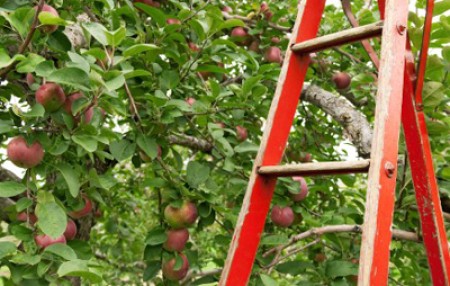
A recent accident in my community (and the resulting fatality) caused me to think about how something as common as an extension ladder could be both useful and dangerous at the same time. As gardeners, we use ladders for a lot of different tasks: picking fruit, trimming hedges, hanging birdhouses, cleaning rain gutters, and accessing items stowed in the rafters of our garage. But how many of us have taken the time to educate ourselves on the basics of ladder safety?
As with any gardening task, there is the right tool for the job at hand. Most gardeners find one of more of the following three types of ladders useful for garden tasks:
Step Ladders: Also called A-frame ladders, these self-supporting ladders usually have wider rungs (for greater stability) and fold together for easy storage. Step ladders should never be used as a single ladder or in a partially closed position. When fully extended open and locked securely into place, they are useful for reaching items in storage, and for routine indoor tasks like hanging pictures.
Extension Ladders: Also called a telescope ladder, an extension ladder consists of two or more segments that can be extended out to reach many feet into the air. These ladders are not self-supported and must be leaned against walls or trees for stability. Extension ladders are necessary for tasks high off the ground like painting the sides of your house or cleaning rain gutters.
Orchard Ladders: An orchard ladder is designed specifically for picking fruit. There are two styles, straight and tripod, both of which typically get narrower at the top. A straight orchard ladder has just two legs, and is designed to be leaned against a supporting branch. A tripod orchard ladder is three-legged step ladder, with the third leg designed to extend out in front of the ladder for extra support.
Unlike some garden tools, ladders may only be taken out of storage one or two times per year so it's important to take a minute or two to inspect them before use. Check the rungs for damage, and make sure they are free of oil, grease, or any substances that could cause you to slip. Look for loose, missing, or protruding screws and rivets, weak or broken rungs, and inspect the ladder for cracks, bent rails, and broken braces.
Always start by reading and following all use labels marked on the ladder. They will provide you with information on the proper set-up, use, and restrictions that apply to your particular model. If possible, never perform tasks requiring an extension ladder alone. Have someone near that can steady the ladder and come to your aid should you get into trouble.

About The Author: Ellen Brown is an environmental writer and photographer and the owner of Sustainable Media, an environmental media company that specializes in helping businesses and organizations promote eco-friendly products and services. Contact her on the web at http://www.sustainable-media.com
Add your voice! Click below to comment. ThriftyFun is powered by your wisdom!